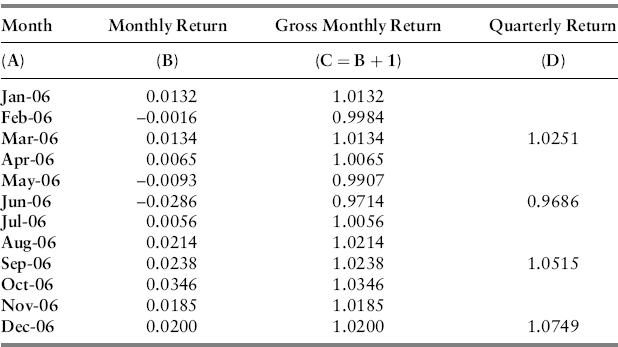Caveats to Return Extrapolation
Practitioners prefer to compare annualized returns and therefore extrapolate higher frequency returns (daily, monthly, and quarterly) to annual frequency. This practice, though common, can be misleading and it is important to know why. Consider the set of monthly returns to the S&P 500 index given in Table 1.3. The returns are for the year 2006.
Table 1.3 Monthly S&P 500 Returns.

We can geometrically link these monthly returns to get an annualized return, which is computed by taking the product of the gross monthly returns in column C and subtracting one, yielding 12.23 percent. This is the return that you would have received had you held the index for those 12 months. The table also geometrically links monthly returns to estimate quarterly returns, which are given in column D of the table. These quarterly returns are then geometrically linked by taking their product (and subtracting one) to get an annual return, also equal to 12.23 percent.
Now imagine that it is April 1, 2006, and having just observed the March return, we estimate the first-quarter return for 2006 at 2.51 percent. Your supervisor wants to know what this is on an annualized basis. In response, you compute ![]() , which upon substitution, computes to percent. What you have done is extrapolate ...
, which upon substitution, computes to percent. What you have done is extrapolate ...
Get Investment Theory and Risk Management, + Website now with the O’Reilly learning platform.
O’Reilly members experience books, live events, courses curated by job role, and more from O’Reilly and nearly 200 top publishers.

